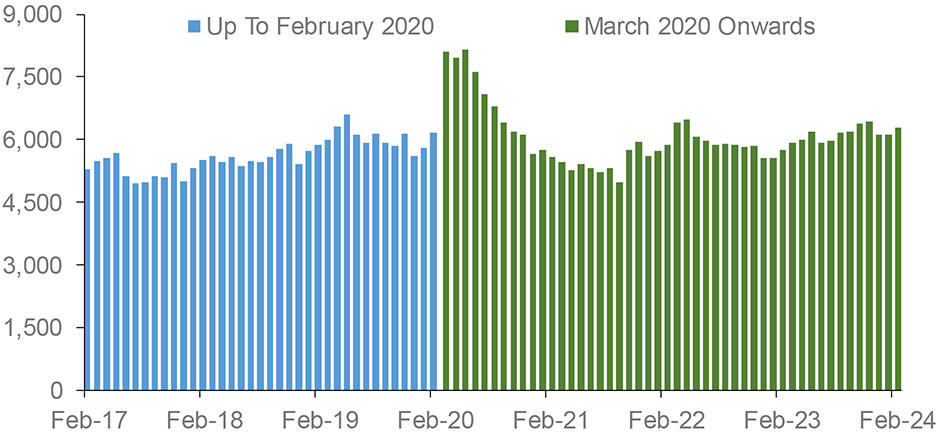Scottish Housing Market Review Q1 2024
Quarterly bulletin collating a range of previously published statistics on the latest trends in the Scottish housing market.
11. Lending to House Builders, Insolvencies and Construction Prices
11.1. Lending to House Builders
The value of loans outstanding to UK firms involved in the construction of domestic dwellings rose by £1.9bn from February to March 2020, an increase of nearly one-third (31%), as shown in Chart 11.1. The sudden increase likely reflected the need for credit to fund short-term liabilities owing to covid restrictions on construction activities and home moves, which had adversely affected firms' income. In addition, firms may have drawn down funds as a precaution, given the economic uncertainty.
From May 2020 to September 2021 the value of loans steadily decreased, falling below pre-covid levels; however, it then returned towards pre-pandemic levels, at least in nominal terms, and was above pre-pandemic levels in 2023. The value of outstanding loans in 2023 was 1.6% higher than the same period in 2022 and 0.5% higher than in 2019. But with the sharp increase in general inflation as well as in construction output prices (compare Chart 11.3), this represents a significant real-terms reduction in lending.

Source: Bank of England
11.2. Insolvencies
Chart 11.2 shows that during the pandemic insolvencies of construction companies registered in Scotland fell from 48 in Q1 2020 to 15 in Q1 2021, with a similar proportional fall evident for England and Wales, likely due to the business support in place. Subsequently, with this support unwinding, new-build construction-output prices increasing (as shown in Chart 11.3) and cost-of living pressures potentially impacting demand, there was an increase in insolvencies for construction companies registered in Scotland. However, latest calendar year data suggest that the number of insolvencies in Scotland has levelled off at around pre-pandemic levels: there were 201 insolvencies in 2023, which is similar to the number of insolvencies in 2019 (209).

Source: The Insolvency Service
11.3. Output and Input Prices for New Housing
ONS construction-output price data shows that the index for new housing, which covers a range of costs (including earnings) associated with building new public and private housing, increased by an annual 4.1% in December 2023, falling from a peak of 12.2% in June 2022 (Chart 11.3).
Data from the UK Government (also illustrated in Chart 11.3) shows that the annual growth rate in the cost of construction materials used in new house building, which had reached as high as 24.0% in June 2022, and thus contributed significantly to output-price inflation for new housing, has fallen sharply to 0.5% in January 2024. There is significant variation around this average with the highest price increases recorded for pipes and fittings (21.1%) and the lowest for steel concrete reinforcing bars (-18.2%).
ONS average weekly earnings data show that annual growth in total pay in the construction sector has slowed consistently from its peak of 14.3% in the three months to June 2021, to stand at 4.4% in the three months to December 2023. (Source: ONS).

Source: ONS and UK Government
Contact
Email: jake.forsyth@gov.scot
There is a problem
Thanks for your feedback